Hệ thống hỗ trợ thực hành lập trình và gợi ý lộ trình thực hành
159
20
2
THÔNG TIN TÀI LIỆU
Thông tin cơ bản
| Tiêu đề | Hệ thống hỗ trợ thực hành lập trình và gợi ý lộ trình thực hành |
|---|---|
| Tác giả | Vũ Văn Tiến, Nguyễn Việt Hoàng, Trần Huy, Nguyễn Hứa Phựng, Trần Ngọc Bảo Duy |
| Người hướng dẫn | PGS. TS. Huỳnh Tường Nguyễn, ThS. Trần Ngọc Bảo Duy |
| Trường học | Đại học quốc gia Thành phố Hồ Chí Minh |
| Chuyên ngành | Khoa học máy tính |
| Thể loại | luận văn tốt nghiệp đại học |
| Năm xuất bản | 2021 |
| Thành phố | Thành phố Hồ Chí Minh |
| Định dạng | |
|---|---|
| Số trang | 159 |
| Dung lượng | 2,6 MB |
Nội dung
Ngày đăng: 03/06/2022, 11:28
HÌNH ẢNH LIÊN QUAN















TỪ KHÓA LIÊN QUAN
TRÍCH ĐOẠN
Sequence Diagram cho chức năng Phân loại câu hỏi
Ví dụ về thông tin của câu hỏi
Ví dụ tổng xác suất tích lũy của các câu hỏi Sơ đồ hoạt động của tính năng gợi ý câu hỏi Cập nhật bảng Submissions cho tính năng gợi ý câu hỏi Kết quả đánh giá hiệu năng chấm bài theo kịch bảnKết quả đánh giá Jobe bằng k6
Ký hiệu vết chân chim của đầu mút quan hệ một và chỉ mộtTÀI LIỆU CÙNG NGƯỜI DÙNG
-
4 1 0
-
43 9 0
-
87 10 0
-
22 28 1
-
60 10 0
-
158 7 0
TÀI LIỆU LIÊN QUAN
-
50 16 0
-
3 6 0
-
79 6 0
-
17 16 0
-
50 2 0
-
3 4 0
-
47 8 0
-
159 20 2